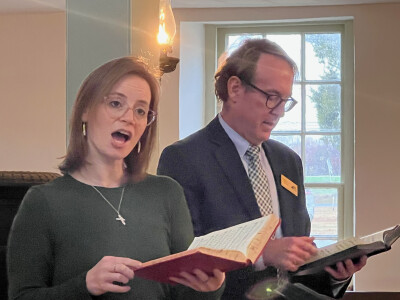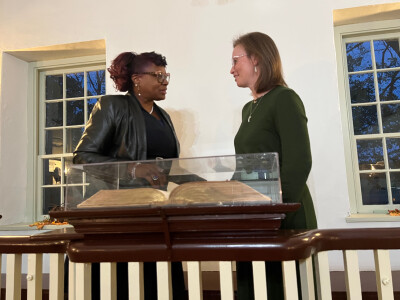Methodism defined at Barratt's Chapel anniversary
By Melissa Lauber
 For Methodists, it was the ultimate “meeting before the meeting.” In 1784, at Barratt’s Chapel in Frederica, Delaware, Francis Asbury met Thomas Coke to plan for the meeting that would form the new Methodist Episcopal Church in Baltimore weeks later.
For Methodists, it was the ultimate “meeting before the meeting.” In 1784, at Barratt’s Chapel in Frederica, Delaware, Francis Asbury met Thomas Coke to plan for the meeting that would form the new Methodist Episcopal Church in Baltimore weeks later.
It was the first time that the sacraments were celebrated inside a Methodist meeting house without an Anglican priest presiding. Through this singular act of grace, they declared their intention to begin something new, independent from the Church of England.
When denominations experience such separations, they have an opportunity to examine and proclaim their identity. Today, with the recent disaffiliations, in which a quarter of the churches left The United Methodist Church, the spiritual descendants of Asbury and Coke have the opportunity to share with the world just who they are, Ashley Boggan Dreff told those gathered for Barratt’s Chapel’s 240th anniversary service.
However, Boggan, the General Secretary of the General Commission on Archives and History, said that to know who we are today, we must understand what it means to be Methodist and Wesleyan.
The term Methodist was first used in public in a newspaper editorial in 1732 when John Wesley and his fellow Holy Clubbers were causing “no small stir” for supporting Thomas Blair, who was on death row for having a sexual relationship with another man. Wesley and his friends believed that Blair was being victimized by other inmates, and they sought to prove his innocence at his trial. Wesley raised the funds when Blair was found guilty in court but sentenced only to pay a large fine.
“In order to ensure that Blair felt worthy of God’s love, of the love of a neighbor, and love of himself, Wesley was willing to risk it all,” Boggan said.
The editorial was the first time the word Methodist was written in a public forum to describe Wesley and his group, but not in complimentary terms. “It described their ‘method’ of living out the love of God to all no matter what,” Boggan said. “It is in doing the unimaginable, the abnormal, going to the places that are unthinkable, and ministering with the outcasts that earned us the name Methodist.”
 However, as time passed, Wesley felt compelled to define further what made his brand of Methodism unique. It was more about preaching outdoors and “submitting to be vile” that gave Methodists their identity. “Being Wesleyan was about intentional, formational community. It was about accountability,” Boggan said.
However, as time passed, Wesley felt compelled to define further what made his brand of Methodism unique. It was more about preaching outdoors and “submitting to be vile” that gave Methodists their identity. “Being Wesleyan was about intentional, formational community. It was about accountability,” Boggan said.
But more importantly, as Wesley wrote in his treatise on The Character of a Methodist, Methodists weren’t about a particular way of speaking, ritual, or doctrine; they were defined by love.
“A Methodist is one who has “the love of God shed abroad in his heart by the Holy Ghost given unto him, one who loves the Lord his God with all his heart, and with all his soul, and with all his mind, and with all his strength,” Wesley wrote.
Methodists also distinguish themselves, Wesley wrote, by their happiness. “God is the joy of their heart and the desire of the soul,” and by their sense of hope. “Methodists are persons full of hope; persons who unconditionally love all of humankind and seek to act upon that love because good is the will of the Lord,” Boggan said.
When we look at our history, Boggan said, it becomes clear very quickly that “above all else, Wesleyans, Methodists, are persons who act. Our ecclesiology is designed, and our faith compels us, not towards opinions, but towards outward acts of love.
The history of Methodism has not always been grace-filled. Methodists have been abolitionists, and they reignited the Ku Klux Klan. They’ve been world leaders for civil and human rights and sought to spread fear and hate and silence diverse voices. In the 19th century, there were approximately a dozen splits within the Methodist Church.
“But we rarely took advantage of these moments to figure out who we are and boldly proclaim our identity, mission, and place in the world,” Boggan said. In most of the splits that occurred, the church refused to change out of fear of losing more people. “But when you let numbers drive mission, mission is hopeless.”
Boggan urges United Methodists to seize this historic season in the church. “We have a moment to be hope-filled, to be future-centered, to be proactive, and prophetic. The question is, are we brave enough to do it?”
But to claim ourselves as United Methodists and be new at this moment, we need to embrace our Wesleyan roots, recognizing that “being sanctified, being holy, was having the mind of Christ and walking and loving as Christ did.”
“At Barratt’s Chapel, immersed in the historic and sacred place, Boggan issued a challenge. “Being a Methodist isn’t some radical, mind-blowing, theologically dense concept. It’s really quite simple. It is faith acted out as love. … How do we move out into this world as a force of God’s love,” she asked. “How do we dare to do as Asbury and Coke did here in this space and do a new thing, moving forward, hand-in-hand, taking the love of Christ out into the world?
